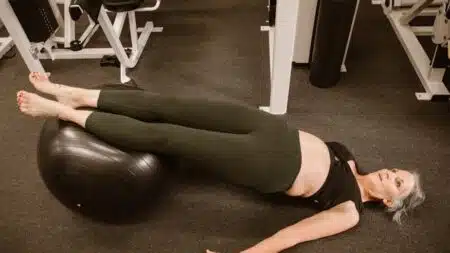Nearly 1 in 5 adults battles irritating pelvic pain at some point – ranging from mild menstrual cramps to agonizing endometriosis. Yet this sensitive subject still remains relatively hush-hush.
Let’s pull back the curtain on proven pelvic pain physical therapy techniques offering real relief when medications and surgery fail. Arm yourself with science-backed solutions to wave goodbye to chronic discomfort for good!
From pinpointing sneaky causes to customized hands-on therapy and self-care strategies, consider this your guide to resolving frustration and taking back control once and for all. Read on to discover your path to healing.
Table of Contents
ToggleDefining the Pelvic Pain Predicament
The term “pelvic pain” gets tossed around broadly, but what does it really mean? This health predicament refers specifically to any bothersome sensations felt in the lower abdominal area, pelvis, perineum or reproductive organs.
The variety of symptoms span:
- Dull cramping aches
- Stabbing bladder pressure
- Constant vulvar burning
- Intermittent rectal soreness
- Vaginal or penile tension
The discomfort may come and go or feel continuous. It can stay put or radiate outward. The intensity ranges from irritating to agonizing. But no matter the specifics, uncontrolled pelvic pain prevents enjoying life fully. The sooner solutions are implemented, the faster comfort gets restored.
Common Diagnoses Behind Recurring Pelvic Pain
So what’s causing all these pesky symptoms? A number of issues can generate pelvic pain, including:
🔸 Painful bladder conditions like UTIs or IC
🔸 Menstrual problems like endometriosis or fibroids
🔸 Bowel trouble like IBS or hemorrhoids
🔸 Abdominal adhesions or scar tissue
🔸 Lingering pain after childbirth
🔸 Muscle spasms and nerve irritation
🔸 Pelvic floor dysfunction – poor flexibility
As you can see, the culprit could originate from the bladder, intestines, muscles or nerves. The first step is getting properly diagnosed. But even then, medicines and surgery aimed at specific organs or tissues often provide incomplete relief from stubborn symptoms affecting multiple interconnected systems.
The Hidden Cause Behind Pelvic Pain: Musculoskeletal Dysfunction
Here’s the deal. The intricate pelvic area has a delicately balanced interplay between structures. When alignment or coordination gets thrown off in any links in the chain, pain can reverberate through the entire region.
Issues like endometriosis or IBS surely disrupt organ function directly. But in many cases, these conditions also cause secondary pelvic floor tension because the body tries to guard and stabilize irritated areas.
This involuntary splinting halts proper mobility. Pelvic muscles and connective tissue become chronically contracted, decreased blood flow drives oxidative damage and inflammation while movement restrictions compress nerves – all fueling swelling, spasms, numbness & more pain.
In short, assorted structural disorders, trauma or repetitive strain breed musculoskeletal impairments that grow progressively worse. And dysfunctional movement patterns drive much of the pelvic agony even in the presence of other diagnoses. The solution? Targeting mechanical causes through pelvic pain physical therapy.
Top Indicators Pelvic Pain Physical Therapy May Help You
Wondering if pelvic floor physical therapy is right for your situation? Consider pursuing specialized care if you struggle with:
➡️ Painful sex, urination or bowel movements
➡️ Lingering postpartum discomfort
➡️ Agony related to menstrual cycles
➡️ Achey tension that comes and goes
➡️ Weak core, poor posture, muscle imbalance signs
➡️ Failure of other pain treatment attempts
Skilled experts pinpoint subtle sites causing big symptoms using unique analysis methods, hands-on findings and personalized programs. Now let’s overview exactly how they work their magic!
Pelvic Pain PT Detective Strategies
Your pelvic floor physical therapist leverages clinical wisdom to unlock the structural source of misery. This gives them power to implement targeted hands-on interventions combined with self-care to treat the root cause of symptoms, not just temporarily ease pain.
Rather than poking around organs with intimidating instruments, your PT performs a meticulous yet gentle evaluation assessing:
🌀 Postural Alignment – Are some areas overly stiff or loose leading to imbalance? Are joints not gliding properly?
🌀 Movement Dysfunction – Are muscle firing patterns out of sync? Is mobility limited in certain directions? Any compensations?
🌀 Soft Tissue Restrictions – Do abnormally dense knotty spots littered with trigger points create referred symptoms remotely?
🌀 Strength & Motor Control Deficits – Are supporting foundations weak? Is coordination impaired?
Your expert analyzes findings across these performance categories to pinpoint prescription solutions reversing identified impairments. Now let’s overview go-to techniques your pelvic pain PT pulls from their toolbox.
Pelvic Pain PT All-Star Treatment Techniques
Through manual therapy, targeted exercise and patient education, pelvic floor PTs design transformational programs relieving a multitude of symptoms. They don’t view the pelvis in isolation, but assess the integration and communication between pelvic and non-pelvic structures impacting function.
Here’s an inside look at their top tricks:
- Myofascial Release: Manual pressure and stretching lengthens shortened, irritable connective tissue – alleviating nerve and vessel compression driving referred pain.
- Neuromuscular Re-education: Using biofeedback, electrical stimulation or ultrasound waves relaxes muscle tension while strengthening weak areas.
- Trigger Point Therapy: Ischemic pressure applied to hyperirritable knotty spots in muscles cuts off blood flow so tissues release. This reduces tightness contributing to spasms and pain.
- Therapeutic Stretches & Exercises: Gentle movements enhance coordination between muscles and nerves – improving mobility and stability simultaneously.
- Cardio & Core Training: Low-impact cardio builds tissue integrity decreasing inflammation while core engagement supports pelvic stability minimizing symptoms long-term.
- Patient Education: Discussing lifestyle factors like nutrition, hydration, rest, eliminating irritants, managing stress empowers self-care.
With a combination rehab approach, most patients experience substantial improvements within 4-6 weeks of starting pelvic floor physical therapy. Best part? No painful exams or side effects – just science-based solutions!
Pelvic Pain Physical Therapy In Action
Wondering how this actually helps transform widespread pelvic pain into localized, treatable issues? Consider this real-life example of receptors gone rogue:
Jane suffers severe bladder pressure and urethral burning making urination miserable. She tries antibiotics and bladder installations unsuccessfully before being recommended for interstitial cystitis surgery as a “last resort.”
Desperate, she investigates pelvic floor PT. Turns out Jane has a history of low back injuries causing chronic tightness of core muscles attaching to the tailbone and pelvis. At the first appointment, her PT finds severely irritated trigger points in the hip flexors and abs placing tension on nearby pelvic nerves.
This perpetual nerve agitation caused NMDA pain receptors in the bladder tissue to become hypersensitive to ANY expansion, triggering excruciating urgency and discomfort even containing only small amounts of urine.
Through manual release of restrictive trigger points, gentle core/pelvic floor muscle re-education, and a home program stretching hip muscles three times daily, Jane experienced substantial relief by week three. After six weeks, symptoms resolved fully without requiring surgery.
The game changer? Pinpointing the trigger points driving secondary nerve overload – not realizing the bladder itself wasn’t the real culprit. Targeted PT literally cured Jane’s formerly “untreatable” pain by treating the true root cause.
Crafting Your Pelvic Pain Breakthrough
If you’re still suffering through unbearable pelvic pain without long-term relief, specialized physical therapy may offer redemption. Pelvic floor experts solve discomfort mysteries when other practitioners simply scratch their heads unsure how to help.
After a thorough evaluation assessing whole-body connections to your symptoms, your PT custom designs a science-backed recovery plan including:
🩺 Hands-on Manual Therapy – Myofascial/trigger point release, joint mobilization, soft tissue massage
🩺 Therapeutic Exercises – Gentle core, pelvic floor, hip focused movement protocols
🩺 Neuromuscular Re-education – Biofeedback, e-stimulation to calm nerves
🩺 Therapeutic Modalities – Ultrasound, heat/ice tissue healing applications
🩺 Body Mechanics Training – Improving posture, daily movement habits
🩺 Home Program – Simple stretches, foam rolling, meditation, etc
With consistency activating personalized treatment plans, most patients finally achieve full pain relief and optimal function without side effects. Consider pelvic floor physical therapy the missing link on your journey to blissful living!



